Cardenche Song: Voices of the soul that resist in the desert

"As a child, I didn't know that my town, full of hills and rock formations, was a fundamental part of the cultural identity of the Comarca Lagunera. I didn't know that something called a cardenche (a type of tree) emerged from the roots of its land, and that no, it wasn't related to any type of plant."
The speaker is Abril Olvera, a resident of Sapioriz and neighbor of Don Guadalupe Salazar, one of the living pillars of an ancestral tradition that is now on the verge of oblivion.
The memory of the community, a small town nestled in the aridity of Durango, is woven with the threads of an ancestral song that crossed borders, carried in the throats of four of its inhabitants.
"I was very young when I heard that in my village lived four gray-haired men who sang old songs, and that because of them the name Sapioriz echoed even in other countries."
The quartet known as Los Cardencheros de Sapioriz, formerly comprised of Fidel Elizalde, Genaro Chavarría, Antonio Valles, and Guadalupe Salazar, became a cultural beacon that attracted, in Abril's eyes, "strange people with cameras hanging around their necks who came to ask about them."
However, the paradox of international fame contrasted with a certain local indifference. Little Abril wondered, for example, why the townspeople themselves showed little interest in her art.
"Some even referred to them and their singing as something boring and sounding like something from the past, and that when they were gone, the lyrics that came out of their mouths would be lost."
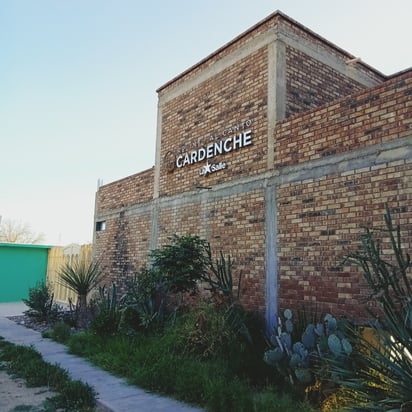
The echo of their song, however, was so powerful that, after resonating in distant latitudes, it prompted the construction of the first space dedicated to this tradition in Sapioriz: the Recinto al Canto Cardenche (Cardenche Song Center). The idea was conceived by students from La Salle Laguna University. After approximately two years of community and academic work, the facility was officially inaugurated on August 8, 2017.
On that memorable day, the Cardencheros themselves, Genaro Chavarría, Guadalupe Salazar, Antonio Valles and Fidel Elizalde, stood as guardians of their history.
With the wisdom of their voices, at the opening event, Abril recovered and unraveled the mystery of her song, explaining that this tradition, born in northern Mexico at the dawn of the Mexican Revolution, was a balm for the laborers of the cotton and mining estates.
Amidst slavery and grueling days, they found in a cappella singing a way to escape reality and express their feelings. The lyrics, laden with sadness, pain, heartbreak, and struggle, gave their name to the expression: el cardenche, a desert cactus whose spines cause excruciating pain when pierced, and even more so when removed.
"It's a metaphor," declared Fidel Cardenchero at the inauguration of the facility: "a comparison between the pain caused by a thorn and the pain caused by love. Both thorns and love are very easy to enter the body, but when they are removed, they inevitably trigger suffering."
For Abril, that night was revelatory. Those in attendance, especially the residents of Sapioriz, including herself, understood everything that day: "We thought the best thing we could do was embrace the tradition and instill in the new generations the importance of preserving it. That's why, today, through this report, I try to capture in words the endless echo of Canto Cardenche: the endemic sound of my roots."
MELANCHOLIC ROOT OF A SONGCardenche singing, also known as garbage dump songs or laboreñas, is a musical expression that flourished in the Comarca Lagunera, a semi-desert region in northern Mexico.
Its origins date back to the late 19th century, in the context of cotton and mining estates, where the migration of poor people from neighboring states such as Zacatecas, San Luis Potosí, and Chihuahua generated a diverse social composition.
In this environment of hard work and difficult living conditions, singing emerged as a symbol of identity and an escape valve for the laborers.
The country folk, who worked, as they say, "from rooster to cricket," found in this song a refuge from their sorrows and weariness.
The activity is distinguished by being a polyphonic a cappella performance, that is, without instrumental accompaniment, ideally with three or four voices, although at its peak it incorporated up to five different timbres.
The notes state that each voice fulfills a specific role: the fundamental or middle voice carries the main melody; the first trailing voice (also called "marrana") provides harmonic and tonal support in the lower range; the contralta or second voice adds drama with its vocal power in the higher ranges; and, occasionally, the arrequinte or requinte provides a high-pitched nuance.
In some groups, a falsetto fifth is added for a strident effect, which is known as "hardening" the voice.
To delve deeper into the above, Don Guadalupe Salazar, a voice of drag, welcomed the authors of this report into the atmosphere of his home. A solitary dwelling that holds the most precious and intimate memories of his journey through the acardenchado song.
The tanned-skinned man, in the warm atmosphere of his patio, remembered that this technique, the dragging, was not his natural voice, but he adopted it to "fight" and keep the tradition alive.
The absence of instruments wasn't an aesthetic choice, but a harsh reality. Don Guadalupe explained that: "The peon didn't know about money; they were paid with a commission. They never had the privilege of owning an instrument, but they did have the desire to express what they felt."
This shortcoming became a defining characteristic. Cardenche singing lacks a fixed metrical rhythm, allowing performers great flexibility in phrasing, with long pauses and glissandos, which soften the intervals between notes, creating a sense of suspense and melancholy. The harsh, broken timbre of the voices reinforces the emotionality, generating a sound that evokes a continuous lament.
FROM 'GARBAGE' TO WORLDWIDE PROJECTION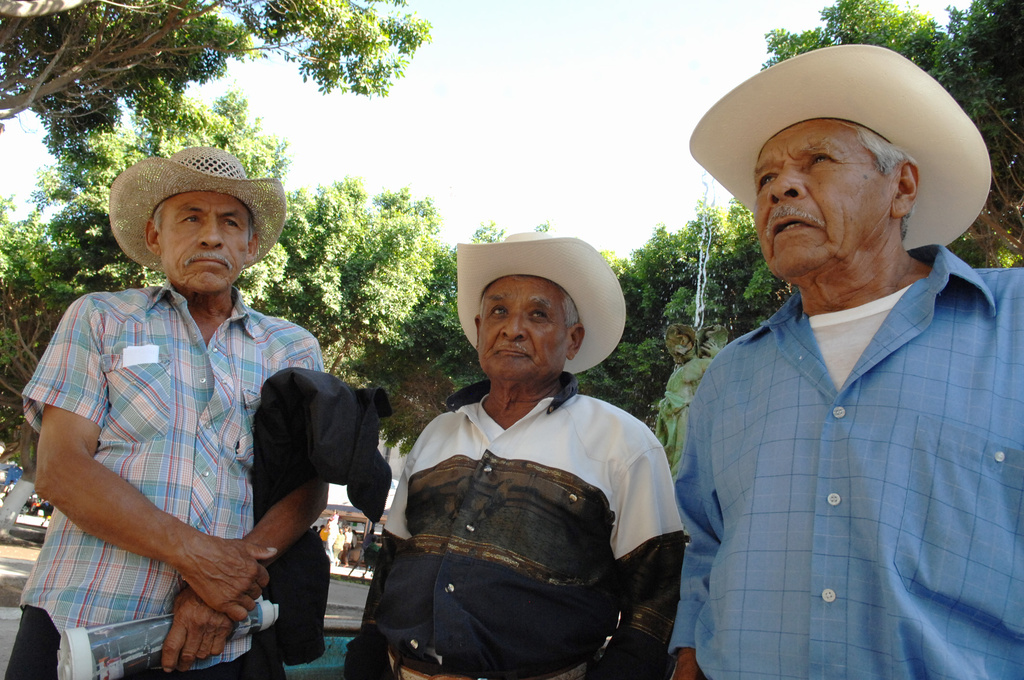
As already explained, the practice of this song was deeply rooted in the daily lives of the peons. Fidel Elizalde explained in 2014, on the national program "Conversando con Cristina Pacheco," that during the hacienda era, workers were not allowed to sing near the main building so as not to "uncover" the bosses.
For this reason, they would gather on the edges of fields, in "garbage dumps" (places where agricultural waste such as corn stubble or sugar cane was accumulated), lighting bonfires to mitigate the cold, a practice that gave rise to the popular category "garbage songs."
There, accompanied by sotol, a traditional drink used to soothe physical exhaustion and the hardships of work, the laborers sang their laments and sorrows.
Don Guadalupe, sitting in a worn rocking chair, added that: "They worked day and night. They left with stars and came back with stars of work."
In addition to these spontaneous moments, cardenche singing was present in community rituals such as wakes and pastorelas, both in religious spaces and in the homes of the deceased, reinforcing its role as a sonic expression of accompaniment, consolation, and belonging.
At another point in Sapioriz, in a house near the cemetery, Ofelia Elizalde, the only female Cardenchera, reinforced the previous idea.
He recounted how in his childhood, without electricity, families would sleep in the courtyard to mitigate the heat, and his parents would "sing," softly at dawn, an intimate and personal song that would "stay in his mind and in his heart."
Thus, in his voice, cardenche singing was traditionally not for public spectacle, but rather part of daily life and community coexistence, activated only at meetings or serenades.
She was the first woman to formally join the group, breaking the perception that it was a song exclusively for men, who sang more freely in public, while women did so in the privacy of their homes.
VOICES OF THE DESERT IN RESISTANCE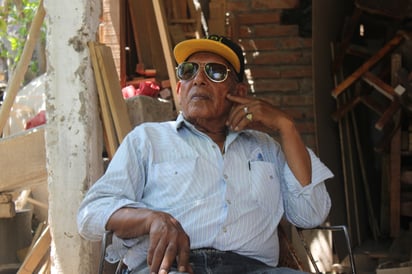
In the recent history of cardenche singing, the names of Ofelia Elizalde and Guadalupe Salazar resonate like persistent echoes in the desert: voices that, despite time and loneliness, firmly uphold a legacy that refuses to die.
Ofelia, 66, joined the group in 2020, but, metaphorically speaking, the song rooted in her homeland has been the soundtrack of her life since she was a child.
"When we were kids, we didn't have a radio or TV, and instead of waking up to watch cartoons like we do now, we woke up to the songs."
She grew up listening to her parents and aunts sing, who, although, as already written, women did not have the same public freedom as men, kept the tradition alive in the privacy of their homes.
"What you experience at home eventually permeates your life," she said, referring to her early connection with the cardenche song. Joining the group, invited by her brother Fidel, was a natural step: "I'd never practiced it, but of course I knew it."
For his part, Don Guadalupe Salazar, the last living member of the quartet, not the first, but the most recognized of Los Cardencheros de Sapioriz, is today a man of almost 80 years old who, because of his love for the cardenche, maintains an unwavering commitment to preserving the song of his people.
At the age of 14, when he moved out of necessity to Delicias, Chihuahua, he discovered his voice. Upon returning to Sapioriz, he joined other young people, and although they didn't sing cardenche at first, Fidel's father encouraged them to try it after noticing their "acardenchado" style.
"We weren't doing very well, but we had a commitment with the previous Cardencheros that we would do everything possible... to ensure this wouldn't be lost," recounted Don Lupe, who, along with Fidel, Antonio, and Genaro, one day promised never to disband.
Their relationship was one of deep camaraderie: "We never fought and everything we did, we did with pleasure."
Today, he not only continues to drawl, but also works with wood, a trade he learned out of necessity and currently practices to keep himself busy. His furniture and small wooden Christ figures are the fruit of his hands, objects he sometimes sells, and moreover, out of a generous instinct, he gives away.
In a twist of fate, he also became a prolific poet. He himself revealed that writing became a refuge after his mother's death.
He has written about love, heartbreak, and a corrido dedicated to his deceased fellow Cardencheros, which was set to music and considered for a Netflix film. He doesn't know the name of the film or how much he will be paid, but what he is sure of is that he wrote it with his heart in his hand, just like when you miss someone deeply.
Although his colleagues are no longer with him, he strives to remain active. In November 2023, he was recognized with the Lerdo de Tejada Medal and named Distinguished Lerdo Citizen for his career as a cardenchero.
Of the original quartet, as previously mentioned, only he survives. Genaro Chavarría passed away in 2018, Fidel Elizalde left earthly life in 2022 at the age of 79, and Don Antonio Valles in 2023 at the age of 87.
The latter, the group's lead singer, had stopped singing about four years earlier due to health problems.
Carrying these absences, just like his voice, Don Lupe confessed to the recorder that he feels different. Sometimes he "has no desire to move forward," but he knows there's still work to be done, such as guiding the new generations, like Juan Aurelio and Jaime Escajeda, so that the echo of the cardenche is not lost.
A SONG FROM THE COUNTRYSIDE THAT RESOUNDED AROUND THE WORLD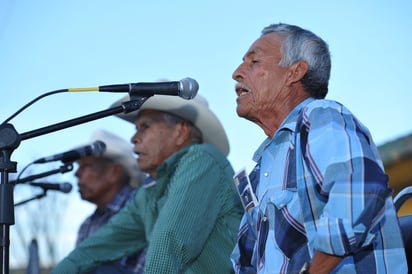
Canto Cardenche has transcended borders, bringing the voice of the desert to international stages. The group, born in Sapioriz, Durango, has conquered cosmopolitan cities like Washington, New York, and Paris.
On a quiet Sunday, Don Guadalupe proudly recalled that travel feat for this report: "We felt very proud... very confident, as we say here, because we were taking everything from our country to other places. Plus, we were very well received wherever we went."
In Paris, at the 2011 Autumn Festival, they shared the stage with renowned musicians. In 2016, the Japanese magazine Latin-a, which specializes in contemporary world music, ranked their song "Un amor pendientes" at number one in Latin American music of the year, sharing the stage with figures such as Argentine artist Fito Páez.
Ofelia Elizalde, on the other hand, although she was not part of the first international tours, witnessed the stories of her brother Fidel, who told her how people "cried" when they heard them sing.
Well, she did witness that emotion. At an event in Mexico City, where the overflowing audience crowded outside the venue, the Cardencheros had to climb onto a raised platform to perform in the open air.
That day, Ofelia's eyes registered the image of a young woman who couldn't stop crying because, from what she heard, the song reminded her of her grandfather, also originally from Durango.
For this reason and more, global recognition came with significant awards. In 2008, they received the "National Prize for Sciences and Arts" in the Popular Arts and Traditions category, an award presented by former President Felipe Calderón.
The documentary film "A morir a los desiertos" (A morir a los desiertos) (2017), directed by Marta Ferrer, was also instrumental in showing the world the richness and fragility of this song, winning international awards such as the "Art Kingdom" at the Los Cabos International Film Festival and the "Best Documentary" award at the Toulouse Latin American Film Festival.
The image of current member Higinio Chavarría, along with Guadalupe Salazar and Ofelia Elizalde, with Lenny Kravitz at the San Luis Film Festival in Arizona in 2021, is a testament to the unexpected cultural resonance of the cardenche.
But… despite international acclaim, a painful paradox persists: the lack of appreciation in their own land.
"Just look at how other places value this song... why isn't the same thing happening here in the community? They don't realize the value it has," Ofelia shared, her brother Fidel Elizalde frequently lamented.
THE REPERTOIRE AND ITS LAMENT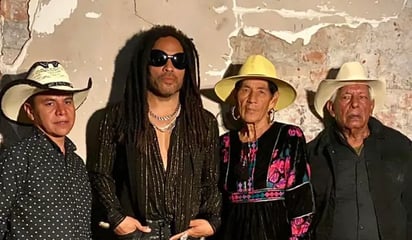
The "acardenchado" repertoire is a vast universe of emotions and narratives that reflects the complexity of life in the Comarca Lagunera through three main dimensions.
In its religious aspect, cardenche chant includes alabados, dedicated to the dead with sacred themes; praises and colloquies, which recount the lives of Catholic virgins and saints; and pastorelas, songs about the birth of Jesus that accompany its staging.
The political dimension is manifested in the corridos acardenchados, narratives of transcendent events or exploits of local heroes, as well as in the tragedias acardenchadas, which recount tragic events, often murders, with motives that may be political or sentimental.
Finally, the social dimension is where the well-known cardenche song itself resides, with themes of love, courtship, contempt, separation, betrayal, and advice.
This is the repertoire traditionally known as "drunk songs," "garbage dump songs," "close-up songs," or "labor songs." This category also includes commercial songs, such as rancheras or Mexican songs, which have been rendered in a cardencha style by performing them in the unique vocal style of the cardenche.
Among the most iconic songs are "A morir a los desiertos" and "Al pie de un verde maguey." The former illustrates the plight of peasants who migrated in search of work, reflecting the loneliness and dangers of the desert.
"Men tend to emigrate to seek other horizons and see if their lives change," explained Don Guadalupe, who also tried to go to the United States as a "wetback" to work as a bracero, but was, he said, detained twice.
The second melody, on the other hand, is more humorous, speaking of the hardships of a hangover and the difficulty of getting credit. One of its verses goes: "I come raw, the barmaid doesn't want credit."
A LEGACY IN DANGER OF EXTINCTION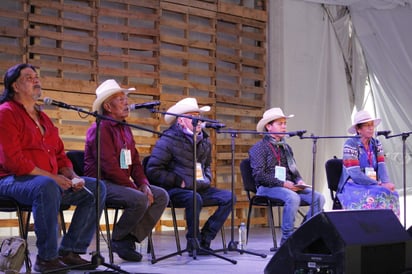
Although there is no decree from the state of Durango, the cardenche song is considered living heritage in practical terms. However, despite efforts to preserve it by the community, educational institutions, and festivals, it is currently in danger of disappearing.
Its decline began with the agrarian redistribution in the 1930s, when peasants became owners of their land and their living conditions improved.
This socioeconomic change, coupled with the emergence of modernity and external musical influences (the jukebox, the radio, the record player, the norteño groups, the bands, and the mariachis), began to displace this ancestral song.
"This important tradition was lost," lamented Don Guadalupe Salazar.
The deterioration is alarming. From the previous generation, which knew more than 100 songs, the current repertoire has been drastically reduced to about 40. Many songs, transmitted orally, have been lost, and of others, only the lyrics remain, but the tune, the soul of the song, has vanished.
The lack of a written record of music and the impossibility of reproducing its essence with instruments are insurmountable barriers to its continuity in pure form.
"It never sounds the same, no matter how much music they put to it, they'll never sing it the way we sing it because that song has no music, no instrument, and the tune of that song with an instrument will lose its origin," warned Don Guadalupe.
Generational change is the most pressing challenge. Ofelia Elizalde noted that while there are young people in the community who are familiar with the song, not all of them dedicate the necessary time to it due to their work responsibilities.
Higinio Chavarría, a current member, for example, is an agricultural engineer and has other responsibilities that prevent him (even if he wanted to) from dedicating the same amount of time to the group as the previous members, who were already retired.
"Cardenche singing needs managers who are attentive, who attend to those who come to ask questions, to learn about them," the cardenchera emphasized.
Currently, Don Guadalupe feels weaker, but with the hope that singing will endure, he continues to teach Juan Aurelio and Jaime Escajeda, with whom, it is worth mentioning, he won first place in a singing contest in Puebla.
He invites anyone who wants to learn more about cardenche to visit his land. He said he's even helped people from Mérida and Saltillo who have come to the community curious to learn about it.
However, he lamented the lack of interest among young people in the community itself, some of whom, like a grandson of Genaro Chavarría, initially showed enthusiasm but later gave up.
"They don't like it anymore. These are things that have to happen. We say we don't want it to end, but (inevitably) it will," said the man who, at least on the Sunday we visited him, traded his hat for a cap and his boots for sneakers.
In addition to the lack of interest shown by young people in safeguarding it, there is the fact that the Recinto al Canto Cardenche, which, although conceived as a space dedicated to honoring and preserving this tradition, in practice (and Abril is a witness) has also been forgotten.
RESIST IN THE DESERT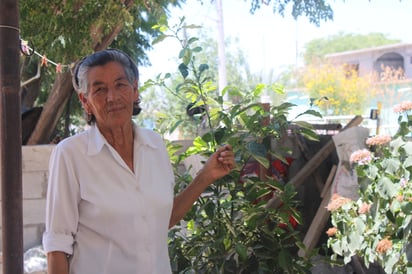
So far we can say that Canto Cardenche is more than a simple musical manifestation: it is the echo of a story, a feeling and a way of life in the desert.
Through the voices of Ofelia Elizalde and Guadalupe Salazar, and the perspectives of those who, like Abril Olvera, have lived around this tradition, the profound personal and familial connection of this song is revealed. While it faces significant challenges, the passion of its last guardians offers hope for Sapioriz, and for La Laguna.
This report joins efforts to raise awareness about its importance as part of our cultural memory, and, why not, calls for its preservation.
"As long as there is voice, there will be song. And as long as there is song, our history will live on," said Don Guadalupe Salazar, who, along with Ofelia Elizalde, Higinio Chavarría, Juan Aurelio, and Jaime Escajeda, represent the voices of the soul that resist from the desert so that an ancestral song like the cardenche does not end up extinct.
“I am going to die in the desert / I am going towards / that sailor's star / just thinking / that I am far from my land / just remembering / makes me want to cry” … These are the verses of a song that, although today it pierces the silence of the desert, persists in the memory of those who refuse to forget.
(Edited by Daniela Cervantes)
elsiglodetorreon





